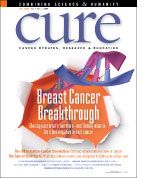Publication
Article
CURE
Message from the Editor
Author(s):
A positive turn of events for a "negative" tumor.
One of the fruits of success from the Human Genome Project that mapped all 24,000 or so genes was our ability to examine which genes are turned on in different cancers. About a decade ago, gene array chips, along with powerful computer analytic capabilities, allowed us to measure many genes simultaneously on tumor specimens, and showed that tumors fall into specific groupings. Interestingly, some groups corresponded to classifications we already knew about, such as hormone-responsive and HER2-positive cancers.
One subtype of breast cancer that emerged did not express any of the three receptors—estrogen, progesterone, or HER2—that we use to direct treatment, so these were termed “triple-negative.” Both clinicians and researchers recognized that this category needed attention because hormonal therapy and HER2-targeted Herceptin (trastuzumab) cannot be used for these tumors, leaving only chemotherapy. Moreover, patients with triple-negative breast cancers have a worse outcome and tend to be younger.
Gene profiling studies began to tell us more about these triple-negative tumors, including that the majority express the same genes as the basal layer of normal breast ducts that give rise to new ductal cells, which led to the “basal tumor” subtype designation. Then the story got even more interesting with the discovery that most patients with BRCA1 mutations who are prone to breast cancer at an early age tend to get basal tumors.
But the tale now takes a positive turn since gene profiling can help identify new targets and vulnerabilities for this tough cancer. The epidermal growth factor receptor, used with some success in lung and colon cancers, is one of those targets.
In another line of investigation, it has been known that the BRCA genes are important in DNA repair, so BRCA-mutant breast cancers can now be treated with drugs called PARP inhibitors that knock out backup mechanisms of DNA repair. Even old-fashioned chemotherapy may be the answer for some triple-negative breast cancers since those that completely respond when chemotherapy is given before surgery are associated with a very good outcome.
It is now becoming very clear that biological classifications of cancers are going to be increasingly relevant for prognosis and choosing the right therapy, as well as identifying new approaches for difficult-to-treat cancers. The diagnostic industry is becoming one of the darling sectors on Wall Street and these tests are being rapidly adopted by oncologists. Even the insurance industry likes this trend because it promises to lessen the use of ineffective therapies.
Triple-negative breast cancer and other genetic classifications are the current poster children for this trend, but similar developments are being seen across the spectrum of malignancies. We are witnessing a recurrent theme where a negative aspect of cancer ends up being the answer to a new treatment. We witnessed this more than 20 years ago when the HER2 oncogene was found to be a negative risk factor, but the anti-HER2 antibody Herceptin changed all that and made HER2-positive breast cancers much more treatable.
With newer gene-, protein-, and cell-based analytic technologies, bioinformatics, and drug development capabilities, triple-negative cancers may ultimately change from a fearsome type of breast cancer to one treatable with unique and effective therapies. In fact, the first step appears to have already happened.






